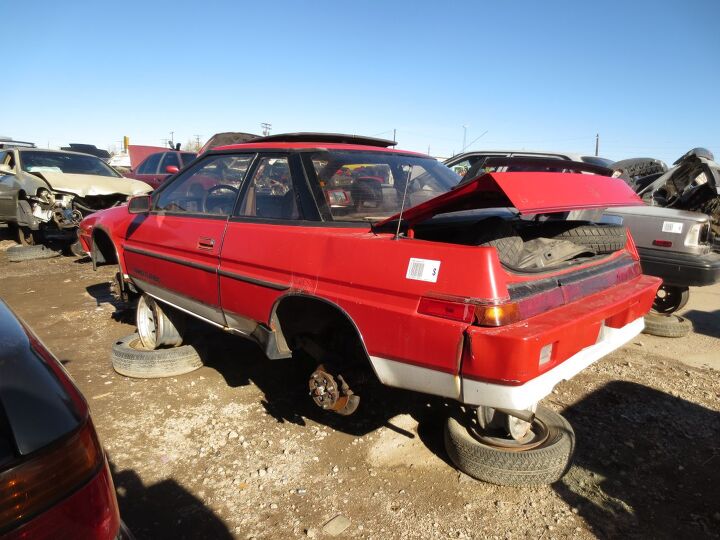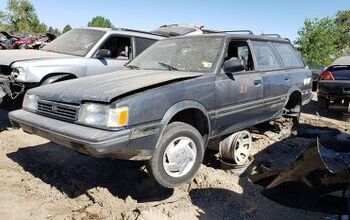Junkyard Find: 1985 Subaru XT 4WD Turbo

The junkyards of Colorado don’t have quite the selection of the ones I grew up crawling around in California, but they do have more Subarus than I ever imagined possible. I’ve been a fan of the Subaru XT since it was new— in fact, I’m half-assedly shopping for one now— and so it’s reassuring to find them during my junkyard visits and know that I’ll be able to get parts. Today’s find is a rare turbocharged four-wheel-drive version from the XT’s first model year.
The XT Turbo had a cockpit that was wild even by the crazed standards of mid-80s Japanese cars. The instrument cluster moved along with the tilt wheel, so that no steering-wheel setting could obscure your view of the gauges. Wait a minute— the XT didn’t have lowly gauges! When you bought an XT, you got the most video-game-ish digital display of them all, and that includes the Mitsubishi Cordia digital dash.
I didn’t have any tools on me when I found this car, so I didn’t pull the cluster for my collection. Should I go back for it?
“TURBO” was the magic word of the 1980s, but you had to be a special flavor of weird to think that the XT Turbo was as mainstream cool as something like the 300ZX Turbo or even the Starion.
These things weren’t cheap. The list price for the ’85 XT 4WD Turbo was $13,589, which was close to 30 grand in 2012 bucks. That was about $1,200 more than the Nissan 200SX Turbo, nearly $1,500 more than a factory-hot-rod Mazda RX-7 GSL, and close to $2,000 more than a Chevy Camaro IROC-Z.
This one is a bit rusty and generally used-up-looking, but it still has a lot of good parts.
The engine in this car made 111 horsepower, which is 27 fewer than the base engine in the 2013 Kia Rio. Yes, we are living in the Golden Age of Horsepower.
We’re also living in the Not-So-Golden Age of computer nannies; rather than a quaint sticker advising the driver to slow down when the slushbox overheats, today’s cars just go into limp mode.
Alcyone!

Murilee Martin is the pen name of Phil Greden, a writer who has lived in Minnesota, California, Georgia and (now) Colorado. He has toiled at copywriting, technical writing, junkmail writing, fiction writing and now automotive writing. He has owned many terrible vehicles and some good ones. He spends a great deal of time in self-service junkyards. These days, he writes for publications including Autoweek, Autoblog, Hagerty, The Truth About Cars and Capital One.
More by Murilee Martin
Latest Car Reviews
Read moreLatest Product Reviews
Read moreRecent Comments
- Honda1 Unions were needed back in the early days, not needed know. There are plenty of rules and regulations and government agencies that keep companies in line. It's just a money grad and nothing more. Fain is a punk!
- 1995 SC If the necessary number of employees vote to unionize then yes, they should be unionized. That's how it works.
- Sobhuza Trooper That Dave Thomas fella sounds like the kind of twit who is oh-so-quick to tell us how easy and fun the bus is for any and all of your personal transportation needs. The time to get to and from the bus stop is never a concern. The time waiting for the bus is never a concern. The time waiting for a connection (if there is one) is never a concern. The weather is never a concern. Whatever you might be carrying or intend to purchase is never a concern. Nope, Boo Cars! Yeah Buses! Buses rule!Needless to say, these twits don't actual take the damn bus.
- MaintenanceCosts Nobody here seems to acknowledge that there are multiple use cases for cars.Some people spend all their time driving all over the country and need every mile and minute of time savings. ICE cars are better for them right now.Some people only drive locally and fly when they travel. For them, there's probably a range number that works, and they don't really need more. For the uses for which we use our EV, that would be around 150 miles. The other thing about a low range requirement is it can make 120V charging viable. If you don't drive more than an average of about 40 miles/day, you can probably get enough electrons through a wall outlet. We spent over two years charging our Bolt only through 120V, while our house was getting rebuilt, and never had an issue.Those are extremes. There are all sorts of use cases in between, which probably represent the majority of drivers. For some users, what's needed is more range. But I think for most users, what's needed is better charging. Retrofit apartment garages like Tim's with 240V outlets at every spot. Install more L3 chargers in supermarket parking lots and alongside gas stations. Make chargers that work like Tesla Superchargers as ubiquitous as gas stations, and EV charging will not be an issue for most users.
- MaintenanceCosts I don't have an opinion on whether any one plant unionizing is the right answer, but the employees sure need to have the right to organize. Unions or the credible threat of unionization are the only thing, history has proven, that can keep employers honest. Without it, we've seen over and over, the employers have complete power over the workers and feel free to exploit the workers however they see fit. (And don't tell me "oh, the workers can just leave" - in an oligopolistic industry, working conditions quickly converge, and there's not another employer right around the corner.)

















































Comments
Join the conversation
My all time favorite Subie. Such an awesome looking car, and a really good example of Japanese design in the 80's. One of the coolest dashes as well.
I almost bought a 1987 XT Turbo 4WD back in 1991. That car was full of all kinds of gadgets. It felt like you were in a video game with the digital dash, and joystick type shifter. I remember that it was the first car I had ever seen that had a tilt steering/dashboard and the hidden door handles. Also, the audio buttons could be pushed in to be flush with the dashboard. The only reason I didn't buy it was that I did some research and discovered that if I ever needed to have work done on the Pneumatic suspension, it was gonna cost a fortune.I ended up buying a new 1991 Civic Si instead.